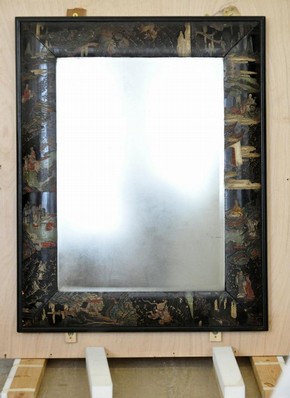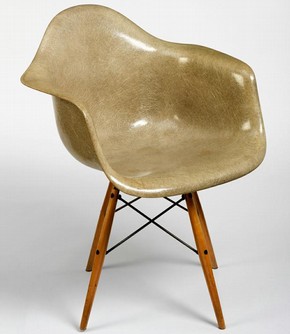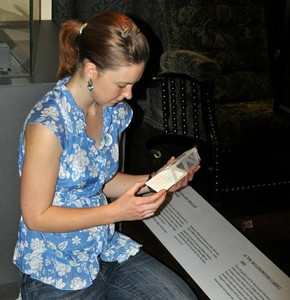Conservation Journal
Spring 2012 Issue 60
Science Section supports the Public Programme
Boris Pretzel, Brenda Keneghan, Valerie Blyth, Bhavesh Shah and Lucia Burgio
The Conservation Science team has a unique range of skills and experience which enable it to make very valuable contributions to the Public Programme’s development of galleries and exhibitions. These skills include object analysis, environmental monitoring and integrated pest management amongst very many others. A brief description of their varied contributions to the new Furniture Galleries may serve as a typical example to illustrate just how the Science team gets involved in such projects.
The Furniture Galleries, due to open in November 2012, will present the Museum's outstanding collection of British and international furniture from the 15th century to the present day. The galleries will focus on questions of form, function, techniques of construction and decoration in the creation of furniture for over six hundred years.
One of the more obvious activities of the Science Section is to provide scientific examination and analysis of museum objects using a range of techniques including optical microscopy, X-ray fluorescence, Raman microscopy, Fourier transform infrared (FTIR) and UV-visible spectroscopy as appropriate. These types of analysis can enable curators and conservators to identify materials and techniques, methods of manufacture and also help uncover the object’s history. This aspect was especially important in the early stages of the preparation of the Furniture Galleries where scientific examination helped reveal methods and techniques of manufacture thereby assisting in the selection of the objects. For example, it was very clear that a Coromandel mirror frame (W.39-1950) had been generously over-painted, but it was unclear how much of the original painted decoration survived underneath (Figure 1). Addressing this query was crucial before the object could make the final list for the new galleries. Using optical and Raman microscopy Object Analyst, Lucia Burgio was happy to report findings suggesting that even under any over-paint, the original colour scheme and structure remains, and the mirror frame could therefore be put on display. Once the final object list is selected, the analysis helps conservators to plan the appropriate cleaning and intervention methods so that resources and deadlines can be structured into the museum project plans. Work undertaken in the Science Section also informs the content of the explanatory texts and labels in the galleries, preventing any mistaken attributions or statements which might reflect badly on the V&A’s reputation.
Materials and techniques analysis are not restricted to older objects. Polymer Scientist Brenda Keneghan, who specialises in modern materials, has been involved in discussions with curators on the history and development of plastics and polymer technology. The development of plastics technology has been a defining factor in the evolution of modern furniture. New materials and moulding processes developed especially during the 1960s enabled exciting pieces of “pop” furniture to be manufactured which revolutionised interior design, as many of these objects could not have been made in traditional materials. Brenda has used FTIR to identify several different plastics which were used in the various iconic pieces of furniture. The Eames chair, for example, (W.15-2007) which was one of the first examples of the use of composite materials outside of military applications, has been identified as a glass-fibre reinforced polyester (Figure 2). Identification of the different polymers in various objects has also informed the choice of synthetic materials to be included in the interactive materials table in the new galleries.
From the outset, it was envisaged that the gallery will have much of its content on open display. As these rooms originally housed ceramics collections, displayed in cases running the length of the galleries, the space has traditionally been very well lit through the expanse of roof glazing. As furniture materials are much more sensitive to light levels and fluctuations in climate than ceramics, Head Scientist Boris Pretzel has been working with Scientist Bhavesh Shah on the climate issues. From early on it was realised that making the galleries suitable for artefacts sensitive to climatic variations in an energy efficient and effective manner would be a major challenge.
Since the millennium work has been ongoing within the Science Section to develop new tools which compare galleries’ performances in terms of climate, and allow quantitative ‘Figures of Merit’ to be assigned. This work was developed further for these specific galleries with the aim of producing as wide a climatic envelope as possible that would be consistent with displaying these precious collections without causing them undue stress and accelerated damage.
Early in 2009 specifications for internal environment were drawn up in a document to be used for selecting consulting engineers to model the space in more detail, with particular emphasis on providing low cost, high efficiency passive solutions to the challenges identified. The Science Section has continued to work with the consultants in order to ensure delivery of a reliable and fit for purpose solution that fits the Museums sustainability targets, but provides adequate protection to the objects on display. For example, the levels of light falling on objects either directly from the sun, or diffused through the skylights, is being monitored by the Science Section to provide data to the engineers and designers so that solutions to manage the levels can be sought.
Advice given by Valerie Blyth, the V&A Preventive Conservator, was required at all stages during the creation of the new galleries. She advised on the implementation of Integrated Pest Management (IPM) and her suggestions included the minimisation of any dead spaces or voids where insect pests could thrive and from where they could initiate their attack on any particularly ‘munchable’ objects, such as textiles, horse hair paddings and upholstered furniture. She advised on the use of Agrodust, which is a dry desiccant dust which kills any crawling insects walking through it, such as moth and carpet beetle larvae. Val has also recommended sealing the perimeter of the galleries at skirting level to prevent the ingress of insects through partition walls. On completion of the project, she will map out the gallery with the relevant curator, locating the best positions for the placement of insect pest blunder traps and moth lures. These will then be inspected as part of the routine quarterly checks of pest traps with the Furniture, Textile and Fashion Department, in line with the other trap checks carried out throughout the museum (Figure 3).
In conclusion, their involvement in the Furniture Galleries demonstrates how the diverse skills of the Conservation Science team help enable the Museum achieve its ambitious Public Programme.
Spring 2012 Issue 60
- Editorial
- Mahasiddha Virupa: an exploration
- Science Section supports the Public Programme
- REMAI: the European Network of Museums of Islamic Art
- Positive Negative
- Cutting character: research into innovative mannequin costume supports in collaboration with the Royal College of Art Rapid Form Department
- The Alhambra Court fire surround
- Moving Meleager
- Utilising skills and creating opportunities
- Preserving intangible integrity
- Re-housing alabasters: an altarpiece framework mount
- Cinderella table
- Bombay Blackwood
- Punch and Bunny: conservation of a pop-up theatre book
- The technical examination and conservation treatment of Portrait of a Lady by Francesco Morandini
- Conservation of a child’s fairy costume
- Conservation 'on a roll'
- Editorial board & Disclaimer


